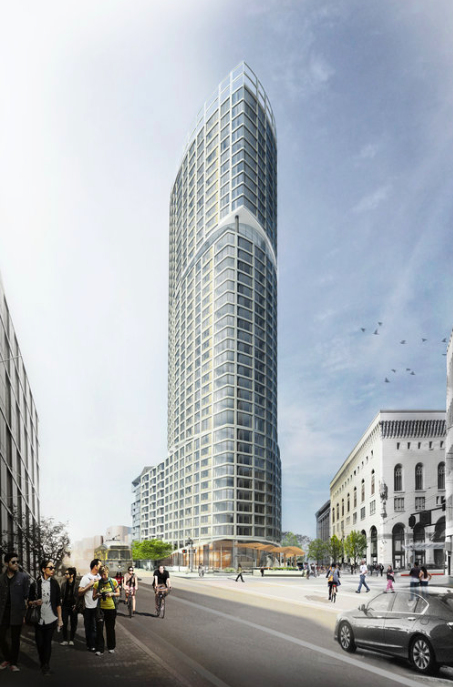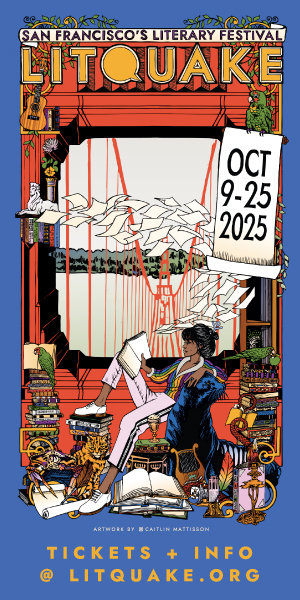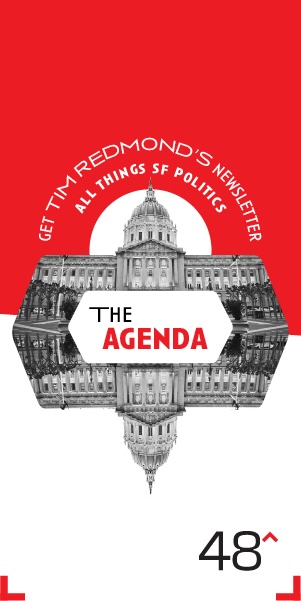The San Francisco supes will vote September 5 on the future of one of the city’s most critical intersections, Market and Van Ness — and the decision will impact tens of thousands of bike riders, Muni riders. and pedestrians who pass through the crowded, windy corner every day.
The project as issue is called One Oak, a 39-story, 304-unit luxury condo complex that is set to replace a small building with a cafe on that corner.

The building would have 139 parking spaces, and no on-site affordable housing. The existing rules would allow only 73 parking spaces.
The Planning Commission approved the building June 15, but Jason Henderson, a professor at SF State and a neighborhood resident and activist, has appealed.
He argues that the environmental impact report on the project failed to consider, among other things, the congestion that will be caused by new residents driving, taking Uber and Lyft vehicles, and getting deliveries in an area that has no street parking most of the time.
In his appeal, Henderson shines a light on a list of serious problems that plague the environmental review not just of this project but of developments all over the city.
For starters, the city admits in Planning Dept. documents that it has no idea how many Uber and Lyft drivers are picking up and dropping off passengers — so the impact of those rides was ignored in the EIR.
We know there are at least 45,000 of these cars in the city, and they are picking up thousands of passengers. But the Planning Department completely ignores that huge traffic impact:
Help us save local journalism!
Every tax-deductible donation helps us grow to cover the issues that mean the most to our community. Become a 48 Hills Hero and support the only daily progressive news source in the Bay Area.
Thus, based on the information currently available it is currently difficult, if not impossible, to document how transportation network company operations quantitatively influence overall travel conditions in San Francisco or elsewhere. Thus, for the above reasons, the effects of for-hire vehicles as it relates to transportation network companies on VMT is not currently estimated.
This is rather stunning. We know there’s a major traffic impact by Uber and Lyft. And we are choosing — in every one of the city’s environmental studies — to utterly ignore it.
The bigger issue here is not just One Oak. There are as many as 7,200 new housing units proposed for the area within a few blocks of Market and Van Ness.
It’s an area with a huge amount of transit, Henderson notes:
Nine important Muni bus lines, five Muni light rail lines, and one Muni streetcar line traverse the corridor, carrying almost 14,000 passengers in the weekday am peak hour and 13,500 in the weekday pm peak hour. Every weekday there are thousands of cyclists using Market Street, with 1,400 in the two- hour pm peak period alone.
The city used very old data and inaccurate models in analyzing the transportation impacts, Henderson notes. The EIR notes that it bases traffic demand models on 1990 census data — and that the city plans to update its transportation planning protocols in 2018.
But this is 2017, and we are relying for an analysis of transportation impacts data from when San Francisco was a very different city. The One Oak transportation study “used 1990 data [that] does not reflect two tech booms and the internet economy to the south of the city,” the appeal notes.
In fact, since 1990:
o The Central Freeway was removed in 2003
o Private commuter buses have proliferated since 2005
o Uber and Lyft have proliferated since 2011
o The City has adopted a new Bicycle Plan in 2009
o The City adopted Vision Zero goals in 2014
o New patterns of e-commerce delivery have emerged instead of storefront retail
o Mid-Market and Market and Octavia have added housing for thousands of new
residents
o 5,469 new parking spaces have been, or might be built in the Hub [surrounding the Oak and Market area].
The analysis of how this new building would impact transportation in the area was based on a regional model developed by the Metropolitan Transportation Commission that deals with a term called “Vehicle Miles Traveled.”
And here we get one of the most amazing parts of how EIRs discuss the impacts of new projects.
The average VMT in the entire Bay Area is 17.2 miles a day. In San Francisco, it’s 14.6 miles a day, according to the Planning Department’s adjustments.
That means if a project won’t likely increase regional VMT to more than 14.6 miles, there is by definition no significant impact.
So take a look at Market and Van Ness. That’s an area that, Henderson notes:
Up until 2015 this TAZ, like the Market and Octavia Better Neighborhoods Plan area, has been characterized by mostly older, pre-automobile era buildings and rental housing. There are very low rates of car ownership and buildings with litte to no parking. In this part of the market and octavia area plan, per capita daily VMT is roughly four miles.
Just bringing traffic up to the city’s average — to where the planners think there’s a significant impact — would “be a substantial increase in traffic,” the appeal notes. I’d say that’s an understatement.
Henderson also asks why there are so many parking spaces when the surrounding buildings will add more than 500 parking spots to an area “where the tolerance for more Vehicle Mile Trips is zero.”
Oh, and since 1990, something else new has happened in the transportation and traffic world: e-commerce and deliveries. Put 304 condos in an already congested intersection, and guess how many times a day people will get UPS and FedEx packages, Postmates deliveries, Eaze deliveries, and other similar services? Think 700 wealthy residents. I would guess at least 100 deliveries to the site every day. Each one involves a truck or private car, and there is no — zero — available parking, so every one will involve a double-parked vehicle.
I don’t know what the answer to this is, but the city needs to look at it.
Then there’s the wind.
Anyone who walks through that area on a regular basis knows that it’s a wind tunnel. If you ride your bike on Market Street, as I often do, you sometimes get walloped by huge gusts as you pass that intersection. The wind whips down Van Ness and — as it is, with the existing buildings — can almost blow you off your bike.
But as Henderson notes,
One Oak EIR contains an extensive discussion of potential impacts of wind on pedestrians and public transit passengers waiting for buses at nearby bus stops. It completely omits analysis of the impact of wind on the thousands of cyclists using Market and other nearby streets. Because the EIR does not study wind impacts on bicycling, appropriate mitigation is omitted.
Again: I don’t know if you can mitigate the wind. But I do know that more tall buildings on that corner could direct more gusts onto an area where we are currently as a city trying to get more people onto bicycles.
The developer, Build Inc., has been very clear about the reasons why it wants to build as much parking as possible and put the affordable housing offsite: The project won’t make as much money without parking.
This is not a middle-class development, it’s all high-end condos, with a pool and concierge services, and the buyers are going to want a parking space.
“If they can’t make a condo project work without this much parking, maybe they should do rentals,” Henderson said.
The Hayes Valley Neighborhood Association and the Haight Ashbury Neighborhood Council have signed on to the appeal.
When it comes to the Board of Supes, London Breed will be in the hot seat: This is her district. She can’t comment in advance, of course, and will have to vote on the merits of the appeal.
But the real issue on the table here is a critical one: Is the city going to make a decision based on what’s most profitable for a developer (one who isn’t ever going to allow affordable housing on site) — or will the supes take a stand and say that what the city needs is more important than how much money a developer can make?
And how are we going to look at the traffic impacts on one of the city’s major hubs at a time when technology has made it ever-more likely that the residents are going to use Uber, Lyft, and delivery services in an area that has, as Henderson notes, zero room for any more cars or trucks?
Henderson told me he is not against the project; he just thinks that the city needs to do a much better job of figuring out what the real impacts will be, and how to address them. Using 27-year-old data and an analysis that ignores everything that’s happened in the tech world in recent years won’t help.
Here are Henderson’s suggestions for the supes:
• Set the parking ratio of One Oak to 0.25:1 as required by Planning Code, Market and Octavia Better Neighborhoods Plan.
• Discourage condominium residents from driving to work – and adding traffic – during Muni peak hours by restricting parking valet operation on weekdays from 7am-10am and 4pm-7pm.
On a larger level, he suggests that the entire way the city compiles data on these types of projects needs an overhaul:
In addition to changing the General Plan Amendment, the Board should direct Planning to:
• Study traffic impacts of current e-commerce delivery patterns and the shift from retail storefront to truck delivery to residence.
• Study the explosion of TNCs like Uber and Lyft. Update traffic analysis to understand potential mitigations such as regulating curb and off-site loading zones.
• Study the traffic impacts of private commuter buses, such as “Google buses” travelling on Van Ness and nearby streets.
• Conduct deeper traffic and transportation impacts analysis in the Hub regardless of the adopted threshold of significance for VMT.
• Study wind impacts on cyclists in all future environmental impact analysis in San Francisco including how sudden gusts might push cyclists into traffic.
Or: Just say the developer needs money, and let it all go. Bets?



